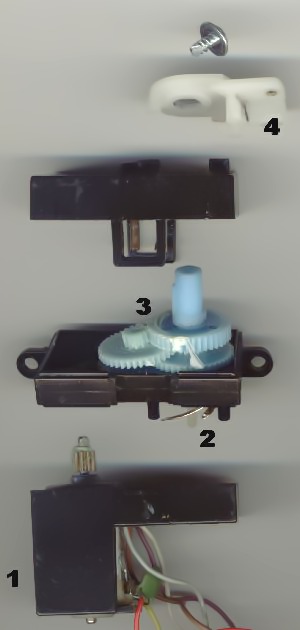Servomechanism
(Redirected from Servos)
Servomechanism or servo is an automatic device that uses error-sensing feedback to correct the performance of a mechanism. It is a type of control system where the output is used to control the performance of the system itself. Servomechanisms are used in a variety of applications, from small electronic devices to large industrial machinery, to improve the precision, efficiency, and performance of the system.
Overview[edit | edit source]
A servomechanism typically consists of a sensor to measure the output performance, a controller to compare the output with a desired performance (set point), and an actuator to adjust the mechanism. The controller uses the difference between the actual and desired outputs, known as the error signal, to determine the necessary action to achieve the desired output.
Components[edit | edit source]
- Sensor: Detects the current state of the system's output.
- Controller: Compares the sensor's data with the target or set point and computes the necessary adjustments.
- Actuator: Implements the adjustments calculated by the controller to achieve the desired output.
Types of Servomechanisms[edit | edit source]
Servomechanisms can be classified based on their power source, control method, or application. Common types include:
- Hydraulic servos: Use fluid pressure to control the system.
- Pneumatic servos: Use compressed air for control.
- Electric servos: Use electric motors, often controlled by microcontrollers or other electronic circuits.
Applications[edit | edit source]
Servomechanisms are used in a wide range of applications, including:
- Robotics, for precise control of the movement of robotic arms and other components.
- Aircraft flight control systems, for stabilizing and controlling the flight path.
- Automobiles, in systems such as power steering and adaptive suspension systems.
- Manufacturing equipment, for controlling the movement of machinery and tools.
- Consumer electronics, such as cameras in autofocus systems and in video game controllers for haptic feedback.
History[edit | edit source]
The concept of the servomechanism dates back to the early 20th century, with significant developments occurring during World War II for use in military equipment. Since then, advancements in technology, especially in electronics and computing, have greatly expanded the capabilities and applications of servomechanisms.
Challenges and Future Directions[edit | edit source]
While servomechanisms greatly enhance the capabilities of various systems, they also present challenges such as complexity, cost, and the need for precise control. Future developments in materials science, electronics, and computing are expected to address these challenges, leading to more advanced and efficient servomechanism designs.
Search WikiMD
Ad.Tired of being Overweight? Try W8MD's physician weight loss program.
Semaglutide (Ozempic / Wegovy and Tirzepatide (Mounjaro / Zepbound) available.
Advertise on WikiMD
|
WikiMD's Wellness Encyclopedia |
| Let Food Be Thy Medicine Medicine Thy Food - Hippocrates |
Translate this page: - East Asian
中文,
日本,
한국어,
South Asian
हिन्दी,
தமிழ்,
తెలుగు,
Urdu,
ಕನ್ನಡ,
Southeast Asian
Indonesian,
Vietnamese,
Thai,
မြန်မာဘာသာ,
বাংলা
European
español,
Deutsch,
français,
Greek,
português do Brasil,
polski,
română,
русский,
Nederlands,
norsk,
svenska,
suomi,
Italian
Middle Eastern & African
عربى,
Turkish,
Persian,
Hebrew,
Afrikaans,
isiZulu,
Kiswahili,
Other
Bulgarian,
Hungarian,
Czech,
Swedish,
മലയാളം,
मराठी,
ਪੰਜਾਬੀ,
ગુજરાતી,
Portuguese,
Ukrainian
Medical Disclaimer: WikiMD is not a substitute for professional medical advice. The information on WikiMD is provided as an information resource only, may be incorrect, outdated or misleading, and is not to be used or relied on for any diagnostic or treatment purposes. Please consult your health care provider before making any healthcare decisions or for guidance about a specific medical condition. WikiMD expressly disclaims responsibility, and shall have no liability, for any damages, loss, injury, or liability whatsoever suffered as a result of your reliance on the information contained in this site. By visiting this site you agree to the foregoing terms and conditions, which may from time to time be changed or supplemented by WikiMD. If you do not agree to the foregoing terms and conditions, you should not enter or use this site. See full disclaimer.
Credits:Most images are courtesy of Wikimedia commons, and templates, categories Wikipedia, licensed under CC BY SA or similar.
Contributors: Prab R. Tumpati, MD




